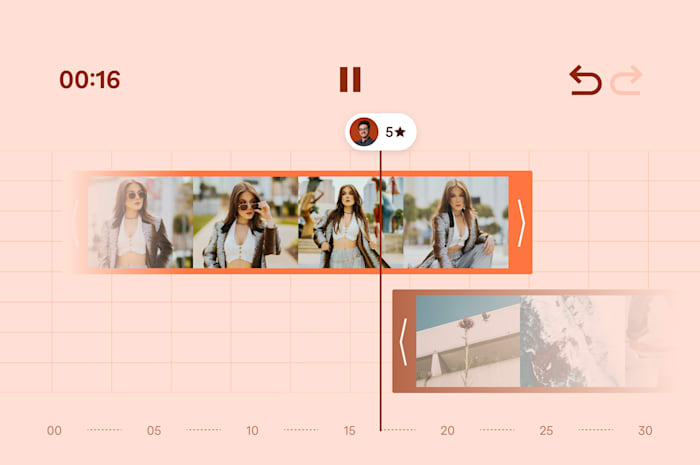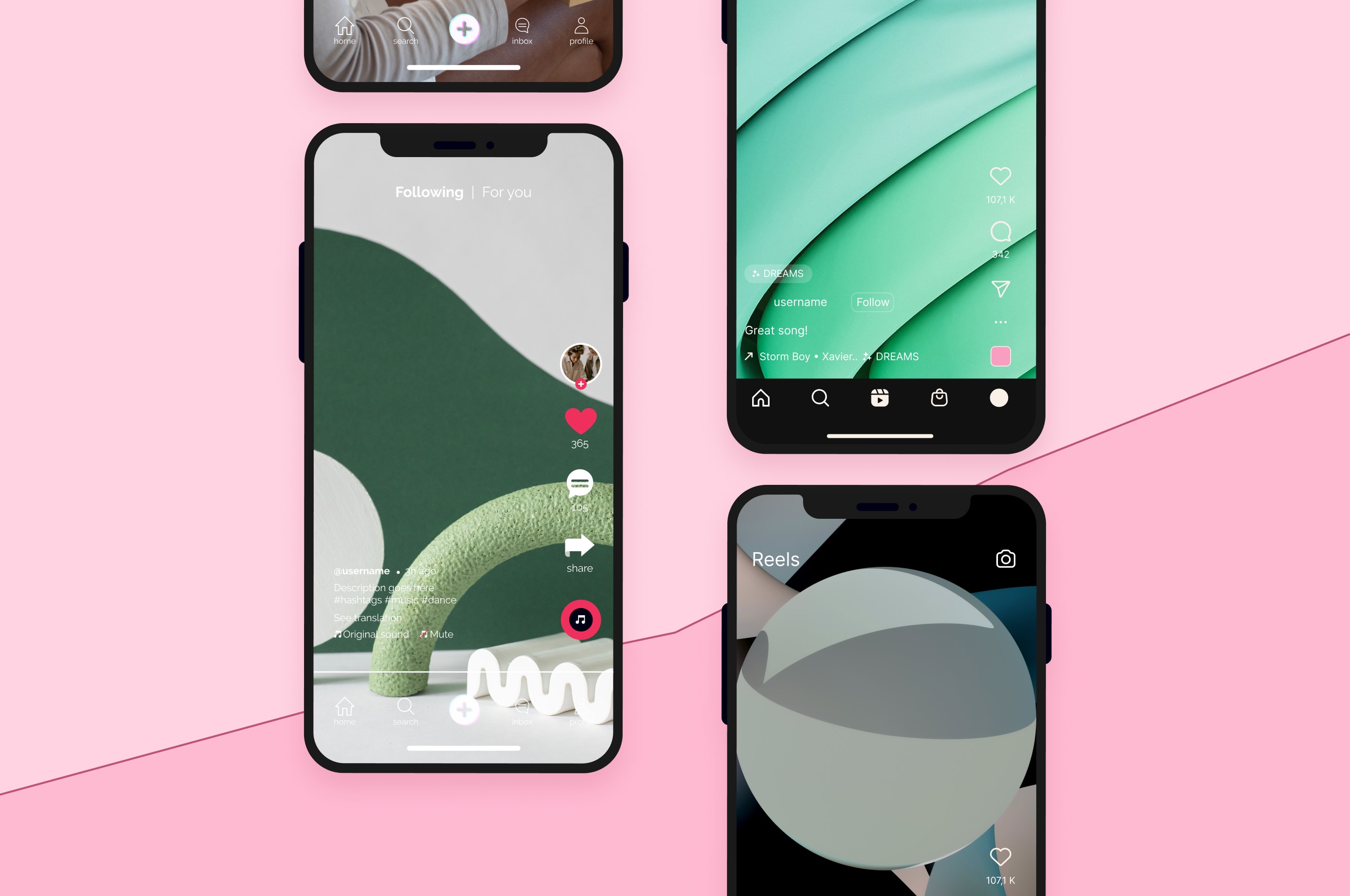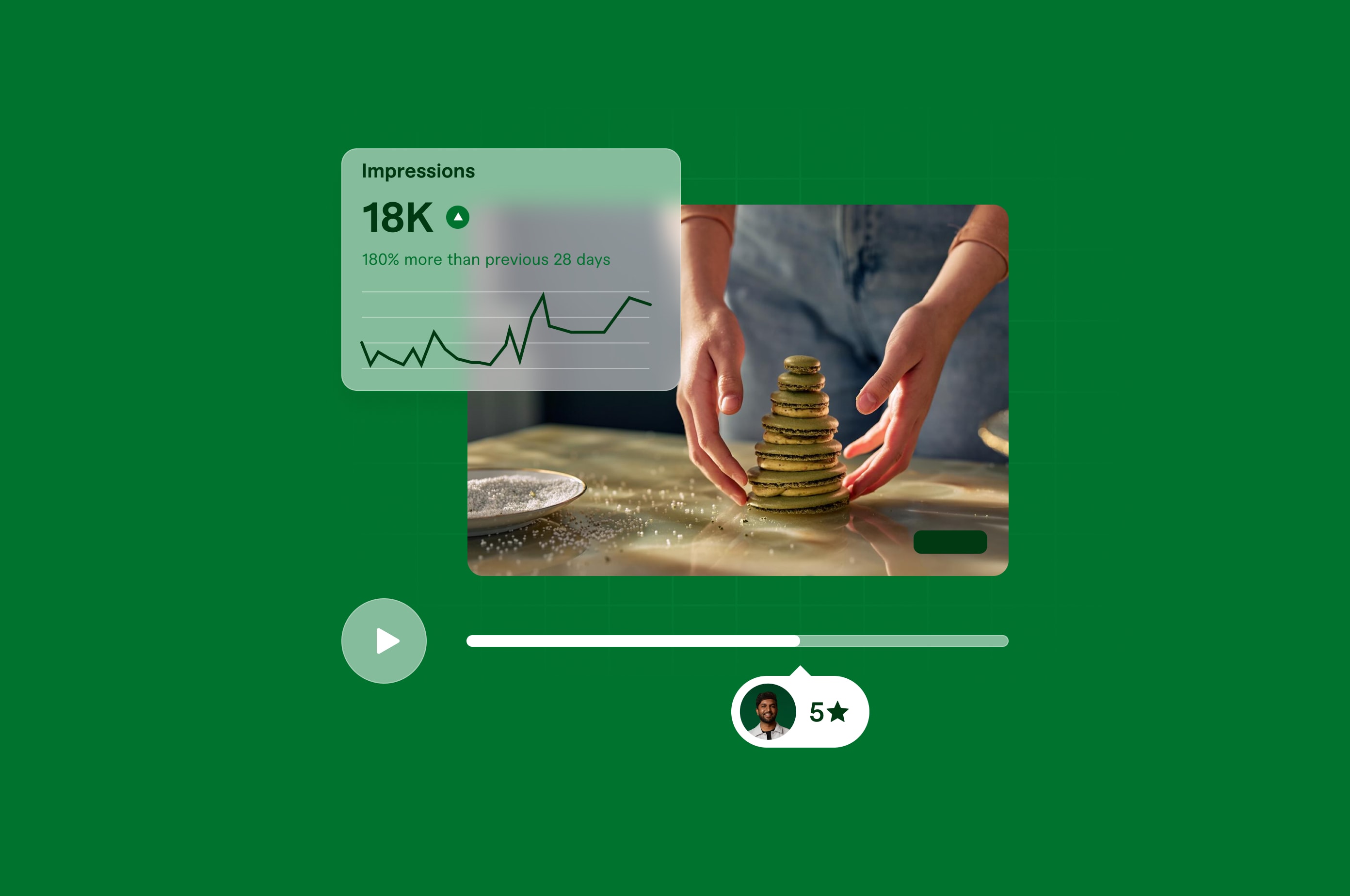Reels vs TikTok: Key Differences & Growth Tips
Reels vs TikTok: Uncover 8 key differences and learn how to use each platform for creator and business growth.
 December 10, 2024
December 10, 2024 7 minute reading
7 minute reading
The debate between Instagram Reels vs. TikTok continues to shape the social media landscape.
When choosing between these platforms, success largely depends on your identity as a business or creator, your content style, and your target audience.
In this article, you’ll learn what makes each platform unique and help you determine the best social media video platform for your goals.
Find a Social Media Video Expert for Hire
What are Instagram Reels?
Reels are a short-form vertical video feature of the Instagram ecosystem, usually in the 9:16 aspect ratio. You can add music, sound effects, voiceovers, stickers, and more with Reels. Unlike Instagram Stories, which only stay on your profile temporarily, Reels stick around on your Instagram profile in a dedicated Reels tab.
Instagram first introduced Reels in August 2020, most likely due to the rising popularity of the short-form video platform TikTok.
What is TikTok?
TikTok is a short-form video platform with videos using the 9:16 aspect ratio. It's owned by the Chinese company ByteDance.
The app started in 2014 as Musical.ly, which ByteDance bought in 2016 and folded the app, creating TikTok in 2018. ByteDance owns a similar app called Douyin, but it's only available in China.
Reels vs. TikTok: What are the differences?
Despite both the Instagram and TikTok platforms being a place viewers go to watch short-form video content, there are quite a few differences between them, including:
Video length
Platform integration
Music and sound libraries
User base
Content style
Engagement
Virality
Monetization
So, let's get into each factor in detail.
Video length
True to the format, you can only create Reel videos for up to 3 minutes. If you want to upload longer videos on Instagram, you'll need to create a video post (R.I.P IGTV) which can be up to 60 minutes long.
On the other hand, TikTok videos that you record in-app can be up to 10 minutes long, and videos you upload can be up to 60 minutes long.
However, just because these video-based social platforms allow you to create content up to an hour long does not mean you should. Many marketers (39%) find success with videos that are between 30–60 seconds long, according to data from Wyzowl.
Platform integration
For platform integration, it's not exactly an equal playing field between Reels and TikTok. For one, on TikTok, video is the whole platform—there's no other kind of content on it, so there's no "integration" to discuss. That's if you don't count CapCut, which ByeDance also owns and is the primary editing app for TikTok videos.
Reels, by contrast, are an integral feature of Instagram's broader content ecosystem and, by extension, the Meta platform.
As a result, Reels is an integrated part of the overall Instagram experience. To get to the Reels page, you tap the Reels icon at the bottom of the screen:
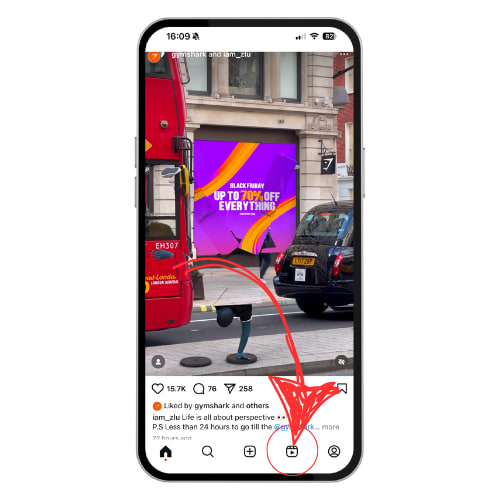
This icon is part of the primary in-app navigation, alongside Home, Explore/Search, Post, and Your Profile.
Music and sound
Given how TikTok started as the music-based, lip-syncing app Musical.ly, it should not be surprising that music and sounds are a super important part of TikTok.
As a result, TikTok has music deals with huge publishers like Universal Music Group, giving users access to millions of songs to use in their content. With deals like these, brand-new tracks from artists often become part of viral trends.
TikTok also allows user to create their own sounds (which can be original audio from the video or a separate recording). These individual sounds can also create viral trends, generating thousands of new TikTok video ideas for others on the platform.
Instagram Reels, on the other hand, doesn't focus as much on the audio experience. The music library is significantly smaller than TikTok's, and looking for trending sounds is a challenging experience.
From personal experience, I find it easier to scroll through the explore page and save sounds that come up for future use. However, this method is long and inefficient, especially in the fast world of social video marketing.
User base
Despite the fact that Instagram has been around for a long time, as compared to TikTok (Instagram launched in 2010), they both have similar younger audience demographics, according to data from Datareportal.
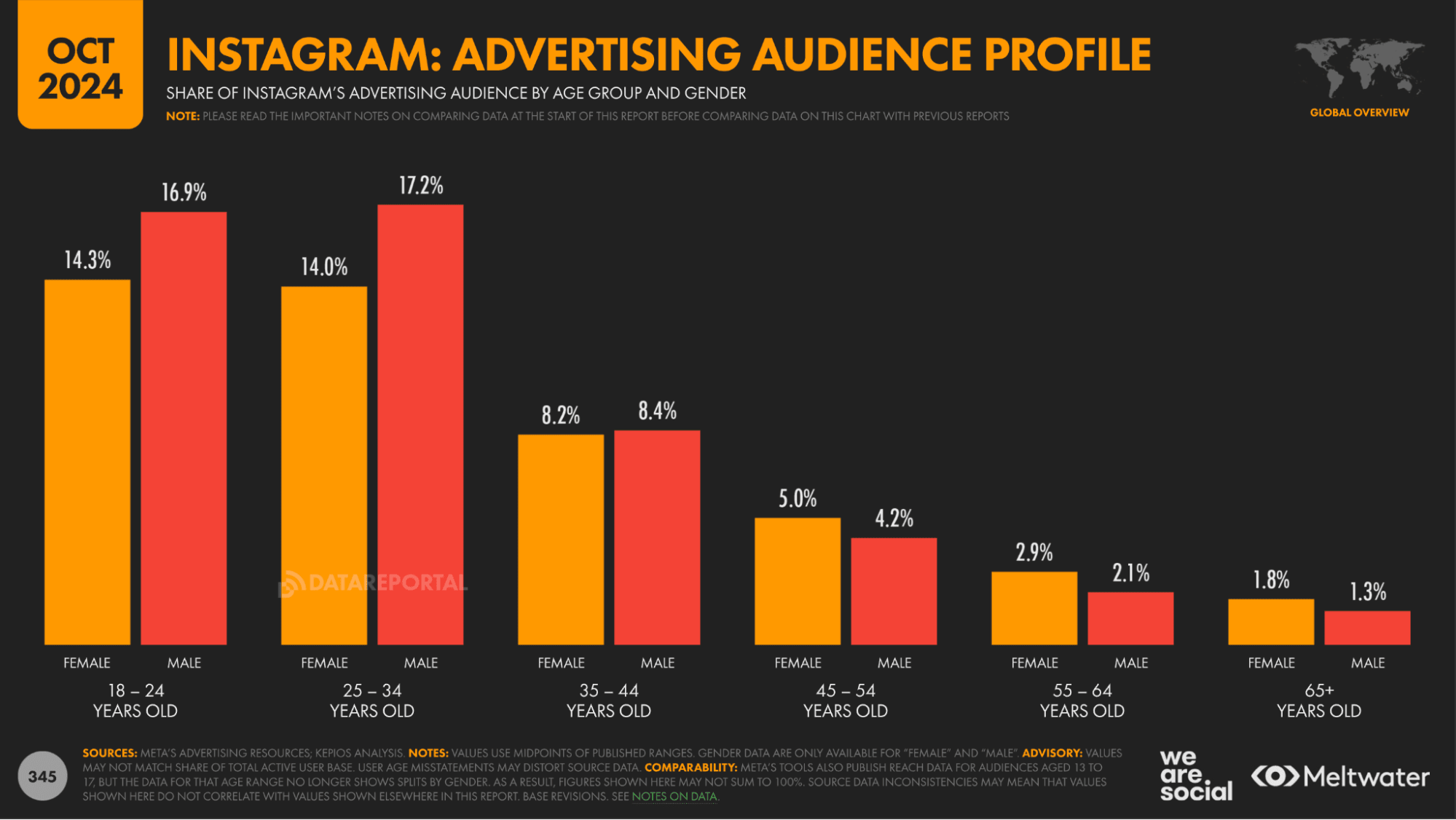
Datareportal
As you can see in the image above, Instagram's audience is segmented as follows:
18–24 years old: 14.3% female, 16.9% male
25–34 years old: 14% female, 17.2% male
35–44 years old: 8.2% female, 8.4% male
45–54 years old: 5% female, 4.2% male
55–64 years old: 2.9% female, 2.1% male
65+ years old: 1.8% female, 1.3% male
This data shows that Instagram's primary audience is Gen-Z and young to mid-Millenial males. TikTok's audience profile tells a similar story:
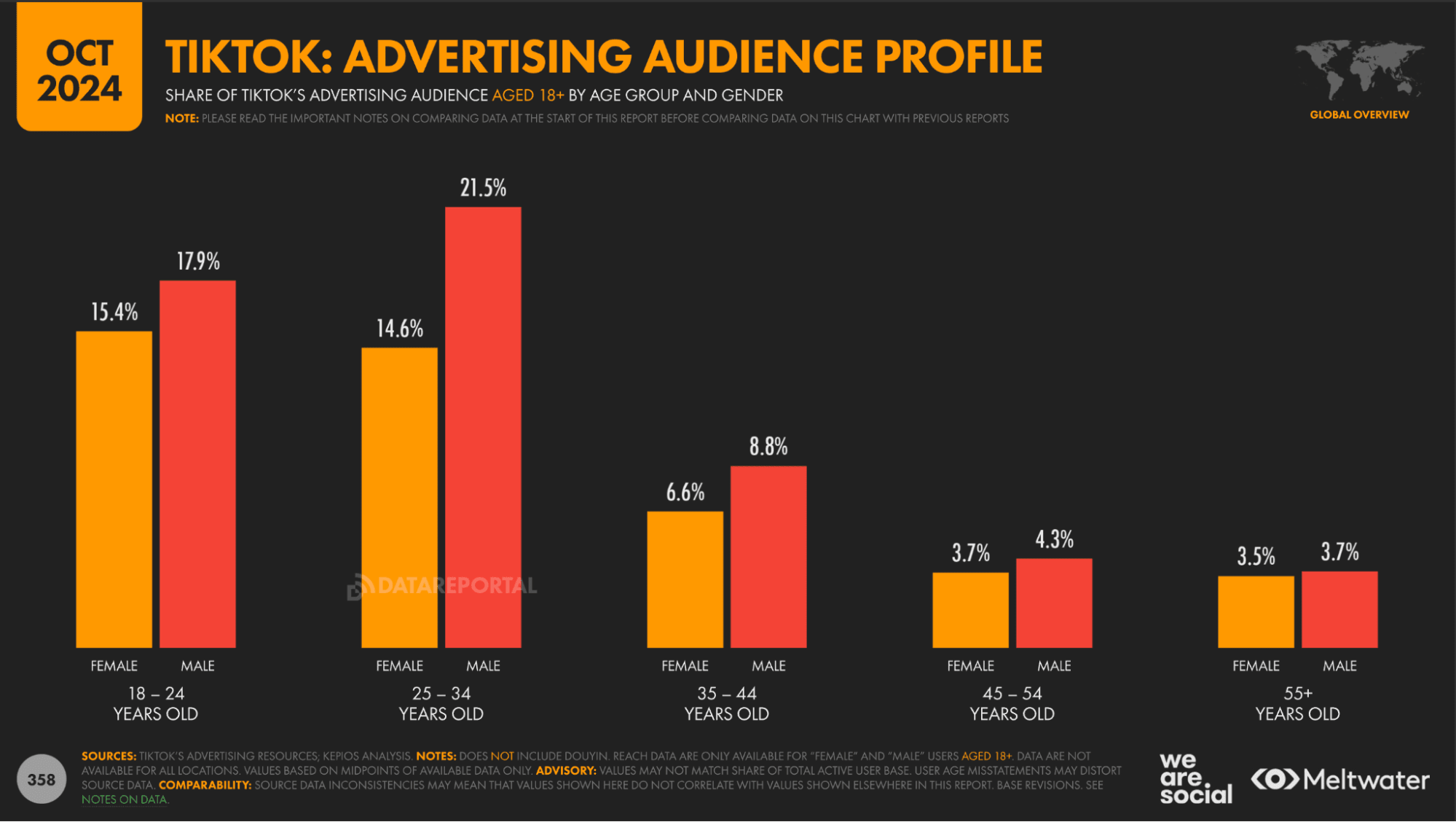
Datareportal
As we can see, TikTok has a similar userbase, but a generally higher ratio of males to females, with the largest user group being 25 to 34-year-old males:
18–24 years old: 15.4% female, 17.9% male
25–34 years old: 14.6 female, 21.5% male
35–44 years old: 6.6% female, 8.8% male
45–54 years old: 3.7% female, 4.3% male
55+ years old: 3.5% female, 3.7% male
Despite the data skewing towards young people, the comparison also tells us that TikTok boasts a larger middle-aged user group, which might surprise some people.
Find a Social Media Marketing Expert for Hire
Content style
Having been an Instagram user since the beginning, I can say that the type of content on the platform is designed to feel polished. People like to showcase their best moments and curate their feeds with aesthetically pleasing content. That expectation is also accurate for Reels.
For example, this Reel shows off a cozy cafe that looks magical, and the content is polished:
In contrast, TikTok's content often feels spontaneous. Creators frequently produce videos "on the fly," capturing moments as they happen—or at least making it seem that way.
For example, this TikTok video shows a user struggling with a relatable problem in the middle of what appears to be a café:
With the iPad in front of her and her sipping a drink, the video tells us she was initially doing something else, like studying. But she experienced the issue of trying to remember a classical piece and decided to make a TikTok about it. This style of content is very common on the platform.
Engagement
If you're looking to build your business presence or personal brand as a creator, one of the important metrics to know is engagement rate. Your engagement rate refers to your total engagement (likes, shares, comments, saves) divided by your total number of followers, multiplied by 100 to give you a percentage.
For example, over the last 30 days, creator Y had:
200,000 likes
2,500 comments
4,000 saves
4,000 shares
Total engagement = 210,500
If they had a total following of 2 million, their engagement rate would be 10.5% (which would be very good). However, let's manage our expectations. According to Metricool, TikTok videos have an average engagement rate of 5.75%, while Instagram Reels average at 5.53%, and there is not much difference between them.
Perhaps the main difference between the platforms here is that TikTok makes it easier to save content in one click. With Reels, you need to click the three-dot options menu to save a Reel.
Virality
When talking about virality, we're talking about the chances of the TikTok and Instagram algorithms boosting your content to more people on the Explore page and the For You page. However, no one knows exactly how these algorithms work and which is better.
We can make educated guesses based on trial and error. For example, the team at Later experimented with content to see which platform was easier to go viral on. The results of this experiment suggested the TikTok algorithm was the best for virality based on audience size and engagement.
However, the best approach is to create great content no matter which platform you use.
Monetization
Both platforms have two similar native monetization options, for example:
TikTok and Instagram have virtual "gifts" that translate into money later. These gifts function like tips that fans can send on individual Reels or TikTok videos.
Both platforms offer a "Creator Marketplace," which creators can use to find brand collaborations and create "paid" content on each platform.
However, that's where the similarities end. Other ways to earn money through Instagram Reels include:
Subscriptions: Users can subscribe to your profile for a monthly fee, and you can offer them exclusive content.
Bonuses: Depending on your location and monetization eligibility, Instagram may invite you to join a bonuses program.
On TikTok, you have a few more methods of earning, including:
TikTok Series: This feature is similar to Subscriptions, except Series are limited to 80 videos, which users can pay to unlock.
The Creator Rewards Program: Unlike Reels, TikTok will pay you for every 1,000 qualified views of your content (also known as RPM) as long as you are eligible (and join) the program.
The significant difference is that the TikTok platform directly pays creators to create engaging content. However, business accounts are not eligible for the Rewards Program.
How to use Reels and TikTok to grow your business
Social video marketing is a core part of many modern businesses and personal brands. But what are some practical methods of using Reels and TikTok to grow your business or personal brand?
There are just a couple of differences in approach between the two, so we'll start with businesses. Then, we'll cover creator-specific growth tactics and what works for both types of accounts.
For businesses
For businesses, consider the following tactics:
Make the most of user-generated content (UGC)
Customers often create content about products or services they enjoy (or do not enjoy). You can feature your customers' voices on your official account to help build brand loyalty.
If your brand is in the early stages, you might struggle to find UGC organically. In these cases, you can find professional creators and ask them to make UGC videos for your brand to build initial hype.
Create ecommerce videos
Customers prefer seeing products in context. That's why 88% of video marketers say video has helped them increase user understanding of their product or service.
TikTok and Instagram Reels also have native shopping features that let you create an in-app store. With this feature, you can link the products you feature in your ecommerce videos and take customers directly to the checkout without leaving the apps.
For personal brands
For creators using Reels or TikTok to grow personal brands, consider these tactics:
Other creators are your community, not competition.
Building a supporting community network is better than competing with everyone else. Share and collaborate with others while fostering positive engagement. With this approach, you're more likely to grow sustainably.
Do not underestimate the value of owned media
When you create content on Reels or TikTok, repurpose the content across owned media channels like building a newsletter or having your own website with a blog, and the other way around. With this approach, you can improve the promotion and distribution of your content and reach a bigger audience.
For anyone
Whether you're a business brand, a growing influencer, or someone who wants to share your story with the world—there are a few tactics that work for anyone looking for follower growth and more engagement.
Have a social media content strategy
There is a difference between strategy and tactics. The strategy is your roadmap—the vision. Tactics are the vehicle that helps you get to the vision. So, without a strategy, you don't have much of an idea of where you're going.
If the idea of building a content or social media marketing strategy sounds a little "out of your league," or you don't have time, you can always hire an expert to help you build a social media strategy.
Edit your video like a pro
Even the most amazing, high-quality footage can fall flat if the edit is bad. Investing in a decent-quality camera, microphone, and lighting is just the start. You'll need to learn how to use video editing software to create a 'style' that is unique to you (and cuts out mistakes). You can start with the native platform’s video editing features, but the user experience becomes a little annoying to use for professional editing.
But if learning how to edit your videos professionally is not your idea of a good time, you can always find professional video editing services to save you time and effort.
Use creative captions
Both platforms allow you to add captions to your videos automatically, which is great for accessibility. However, captions also allow you to make your videos even more engaging by giving them some creative flair. With this approach, your caption style also becomes part of your brand.
A professional video editor can usually handle the work of creating captions. However, if you have a handle on basic fine-cut editing and want to make your videos more interesting, you can hire an expert to make creative captions for you.
Hire your next social media partner on Fiverr
If you need assistance with scripting or editing your videos, social media management, or even building a full team of social media video experts for content creation, Fiverr connects you with the right partners to meet your needs.
Ready to take your social media to the next level? Sign up for a Fiverr account for free today.
TikTok vs. Reels FAQs
1. Is Reels doing better than TikTok?
Short answer: no. TikTok videos have a little more engagement than Reels overall, and TikTok offers more opportunities for content creators to monetize their content. Perhaps if the U.S TikTok ban comes into effect, then Reels or YouTube Shorts would likely take its place.
2. What is the downside of Reels?
For professional creators and business brands, Reels has a few downsides:
You can schedule Reels that use branded content features and product tags, making it more challenging to stay consistent.
The Reel’s music and sound library is more limited than other platforms like TikTok and YouTube Shorts.
While the content style of IG Reels might be better for brands (it's more curated), it can lack the authentic and raw feel of TikTok videos.
3. Should I post on Reels or TikTok first?
You'll often find people saying, "Oh yeah, I saw that on TikTok already." That's because widely-known trends typically start on TikTok and make their way over to Reels later. With this in mind, it's better to post on TikTok first.
4. Why do people prefer TikTok over Instagram?
Creators tend to prefer TikTok over Instagram because TikTok has more ways to earn money with content. Additionally, TikTok is purely a video platform, whereas Instagram combines photography and video. As a result, people looking for video content tend to pick TikTok first.


